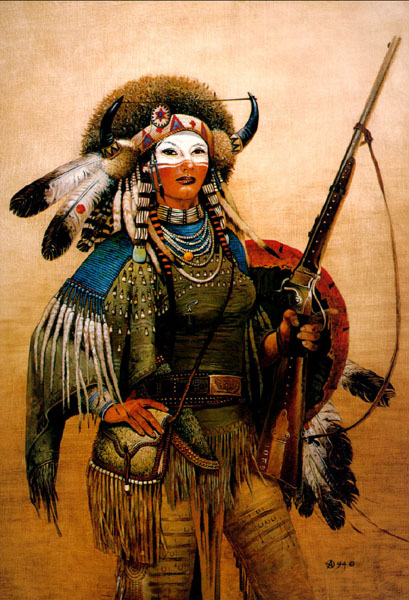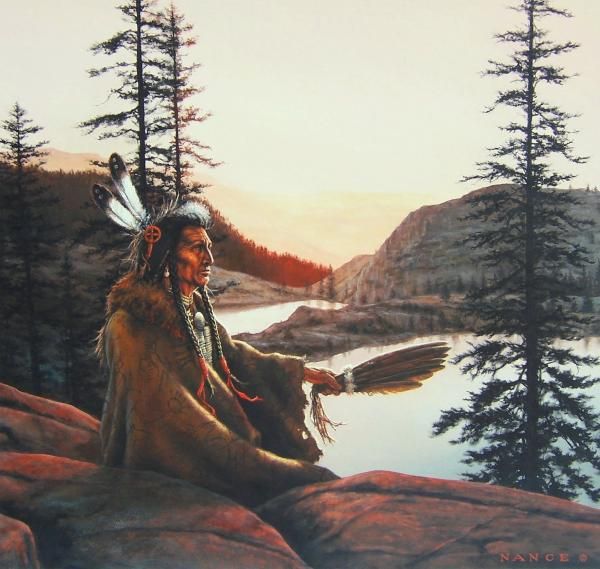8*American Indian Mythos*8

8*American Indian Mythos*8

|
|
|
|
|
|
|
|
|
|
|
|
|
|
|
|
|
|
|
|
|
|
|
|
The gods of the Indians of North America
were as close to nature as their worshipers could make them.
The natural
world is the most important aspect of the Indians' existence.
The gods will always prefer to
appear in the form of a creature of the land.
They can, if necessary, appear in human
form, but such apperances require great energy and may only last a short
time.
In all Indian rituals where a cleric wants
to control something, he or she
must have part of it already. If the cleric
is summoning rain he or she must
sprinkle water on the ground in the process
of the spell. If the cleric is casting
a quest upon
a being for whatever purpose, he or she must have a part
of that being for the spell (a piece of
hair, article of used clothing, etc.).
The symbolism of a <Ren> is very important
to the Injun, so important
that no charm spell will work on an Indian
priest without knowledge of
that priest's name. All Indian rituals
involving demons || devils
require the
use of a large fire for control of the
creature.
Rituals revolve around the seasons. The
ebbing of one season into another
is a time of sacrificing important possessions
of the tribe. Food, finely
made jewelry,
weapons used successfully in battle and the like are are burned
at these times for the good of the tribe
in the upcoming season. Indian
clerics are expected to be apart from
the tribe daily in meditation with the
village's patron deity. When great evil
comes on the tribe, it is up to the
cleric to protect the tribe, either by
direct action || personal sacrifice.

All Indian clerics dress with a number
of magical symbols && relics that
they have fortified with holy power. These
relics are buried with the cleric
in the event of his death.
The selection of these symbols is personal to the
cleric, based on visions he will have
received at the beginning of his or her
career. One of these symbols will always
reflect the patron deity's symbol.
Young Indian clerics enter battle alongside
the rest of the warriors of the tribe,
while the older clerics attempt to enlist
the help of the tribal gods for
the battle.
It is the job of the tribal priest to make the warpaint of the
warriors and bless
the men and weapons before battle.
The tent or lodge of the cleric(s) is a
place taboo to the rest of the tribe and
supposedly guarded by strong spirits.
Worship of most deities is held in the open.
<remem: add Ithaqua>
| All | Raven, Hastseltsi |
| Warriors | Tobadzistsini |
| Thieves | Coyote |
| LG, NG, CG | Heng |
| CG | Hotoru, Snake-Man |
| CN | Coyote |
| Hastsezini | The god is very fond of destroying villages
by fire if they do not make sacrifices to him.
All tribes fearing the god's wrath (especially in the dry season) will sacrifice food and fresh meat to him by burning these items at high noon. |
| Shakak | Those that sacrifice to him can often
lessen the force of winter, but no one prays to this evil being for fear
that he will come.
Sacrifices always take the form of burning precious possessions during the dead of winter. |

Great Spirit
Sun
Moon
Earth
Morning Star
Wind
Fire
Snake
Southwest (Territory of New Mexico)
mountain lion (BH2)
bear (BH2)
boar, wild (BH2)
rattlesnake (BH2)
wolves (BH2)
buffalo (BH2)
varmits (BH2)
Ral Partha, Dragon #82